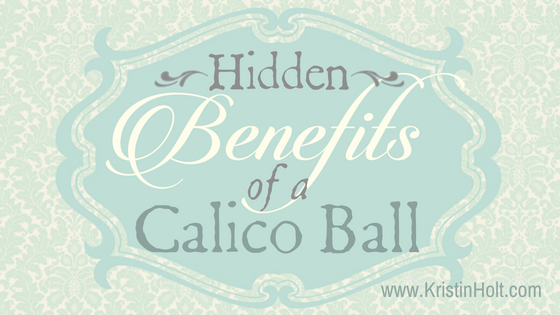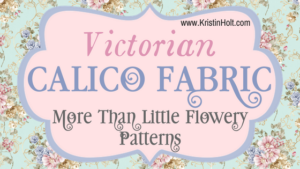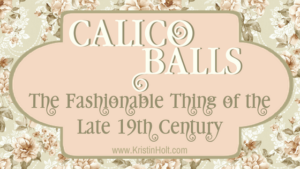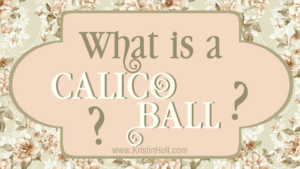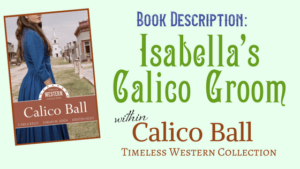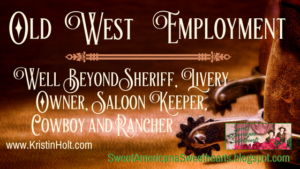Hidden Benefits of a Calico Ball
Hidden Benefits of a Calico Ball
.
.
Some Calico Ball Benefits are Self-Evident
.
As I’ve shared in earlier posts, the Calico Ball was designed by a New York fashionable hostess. The charity event asked (and expected) guests would donate their once-worn gown or necktie or suit of clothes. Or equivalent yardage of calico fabric. Why? In a charitable effort to clothe the less fortunate.
The fashion for Calico Balls quickly spread nationwide, fashionable from the mid- to late-19th century.
.
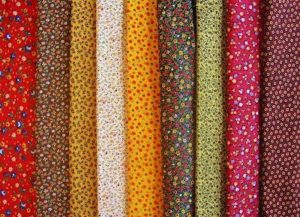
Calico Fabric. [image source]
.
Hidden Beneficiaries
.
As noted in the various newspaper articles posted in recent blog articles, various groups raised funds to meet the needs of the poor. We’ve seen various Ladies’ Aid Societies, Clubs, individuals (like the wealthy hostess in New York). It’s no surprise that other service organizations–like Firemen–would participate. They held balls anyway… might as well give the festive occasion a popular theme.
.
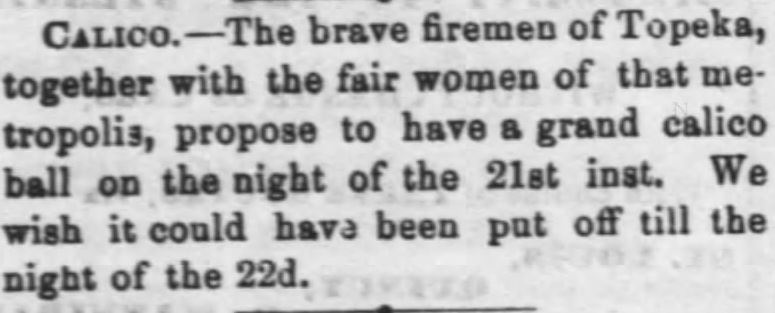
Lawrence Daily Journal of Lawrence, Kansas on February 15, 1872.
.
Consider Merchants and Dressmakers…
.
All of those calico dresses had to come from somewhere.
In the San Francisco Chronicle, on the same page as an advertisement for the upcoming Calico Ball, merchants advertised appropriate fabrics.
.
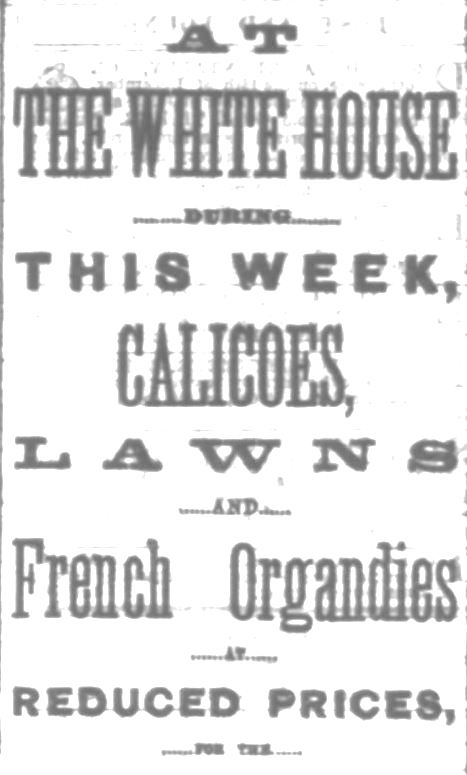
Calico On Sale for Calico Ball. Advertisement in the San Francisco Chronicle of San Francisco, California on January 4, 1874.
.
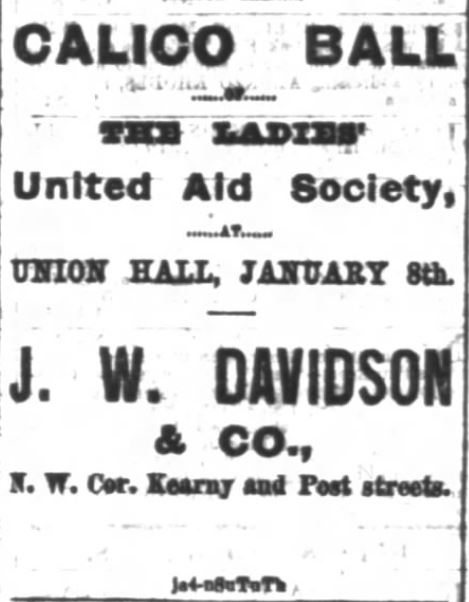
Advertisement for upcoming Calico Ball event. The San Francisco Chronicle of San Francisco, California on January 4, 1874.
.
A fun spot of humor was published in Kansas when “a loud bawl for calico” occurred at the dry good stores in Topeka Kansas. Just in case this vintage newspaper clipping is difficult to read, it’s worth a transcription:
.
The calico ball does not come off until Friday night, but there was a loud bawl for calico yesterday at all the dry goods stores. To-day will be the last Sunday in which the ladies can refrain from attending church in order to complete their costumes.
.
~ The Daily Commonwealth of Topeka, Kansas on February 15, 1874.
.
And now the same article, as a digital newspaper clipping:
.
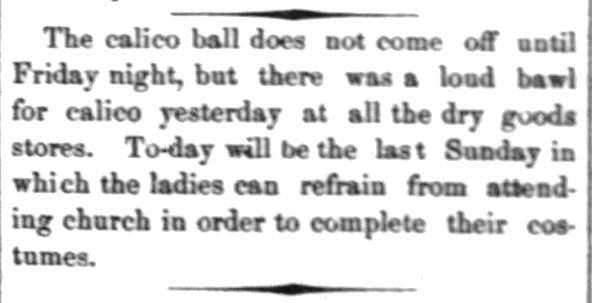
The Daily Commonwealth of Topeka, Kansas, February 15, 1874.
.
Don’t forget Personal Improvement
.
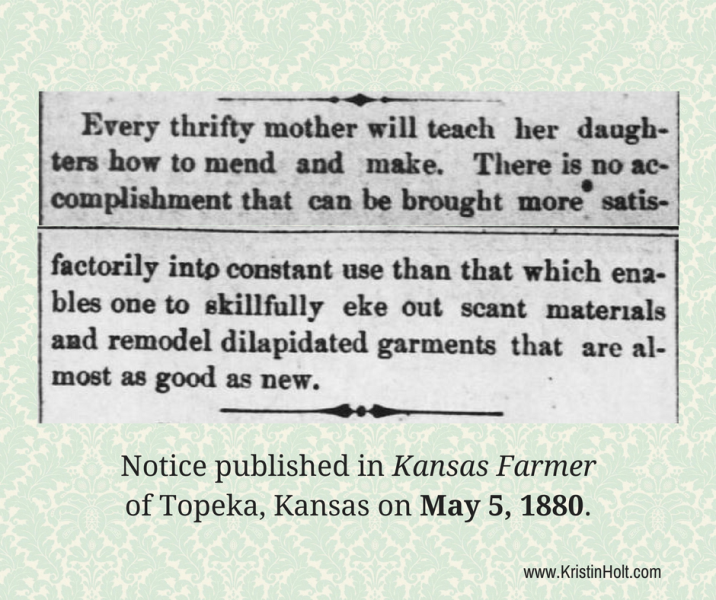
Notice published in the Kansas Farmer of Topeka, Kansas on May 5, 1880.
.
True, plenty of ladies were sewing their own dresses. The vast majority of women and girls (through the whole 19th century) did all of the family’s sewing and mending. People viewed sewing as a necessary task, much like food preparation, vegetable gardening, and bottling produce.
The well-to-do could afford to pay someone else to do their sewing–a seamstress, dressmaker, or merchant tailor. Later in the nineteenth century, ready-to-wear clothing was available for sale in stores. Yet many women determined ready-made clothes were ‘inferior.’ Why buy something that didn’t fit as well as what they could make themselves? Factory-made clothing was often inferior to their own workmanship.
.
The Girl of To-Day.
.
The girl of to-day is generally proficient in needle-work. She cannot only alter her own dresses, but cut and make those and her underclothing as well. aShe has a knack at trimming her hats and furnishing up her wardrobe, and does her full share at helping the dressmaker, who comes to assume charge of the spring and fall sewing. She understands the various branches of mending, and takes that division of labor off her mother’s hands, as well as the care of parlors and dining-room, the arranging of flowers, the supervision of the manners and apparel of the younger children, and sometimes of their studies, too.
.
“Let full justice be done to the girl of the period,” or, rather, let there be a clear comprehension of what should be really represented by that much-abused phrase. It is not fair to take the weakest specimens of the sex as types of a class compromising workers, with strong conceptions of life, its responsibilities and burdens, and a steady purpose to bear them according to the best of their ability. —Philadelphia Press
.
~ Clinch Valley News of Tazewell, Virginia, August 6, 1886.
.
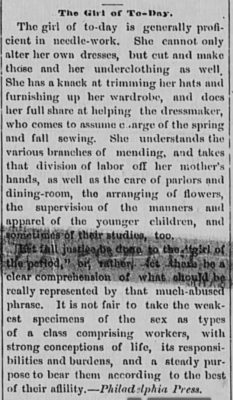
The original is difficult to read: Clinch Valley News of Tazewell, VA. August 6, 1886.
.
.
Other Businesses Benefited…
.
Rental of the dance hall (or social place)… [Wait ’til you see where my Calico Ball was held in Isabella’s Calico Groom [CALICO BALL: Timeless Western Collection.]
The bakery who sold the refreshments for the event.
How about the ice company? Yes–they certainly had COLD punch or lemonade at these events.
Shoemaker?
.
.

.
List of Beneficiaries
.
I identified merchants who sold the calico. Can you imagine the increase in sales?!
Dressmakers, seamstresses, and merchant tailors enjoyed more business.
And young girls themselves, whose sewing and fitting skills benefited from practice.
Supporting merchants sold ice, cake, lemons for lemonade, etc.
And someone owned the hall that garnered rental fees.
.
Who else, or what else, might you identify as a Hidden Benefit?
.
Please scroll down and comment. We’d love to hear your ideas.
.

.
Up Next!
Victorian Calico Fabric: More Than Little Flowery Patterns
.
.
.
Don’t Miss Out!
.
.
Updated March 2021
Copyright © 2018 Kristin Holt LC
Hidden Benefits of a Calico Ball

